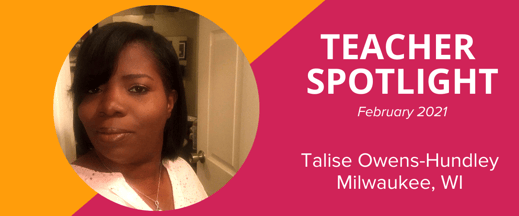
In honor of Black History Month and as part of our ongoing Teacher Spotlight series, we recently asked the CLASS Community to nominate outstanding Black educators who are making a difference in their schools. With over 200 nominations, it was certainly difficult to pick just one winner, but Talise Owens-Hundley stood out. Talise has been teaching for 15 years and is currently a lead teacher at Next Door in Milwaukee, WI. The program focuses on getting children ready for school with academic and social-emotional learning as well as a range of health services– at no cost to their families.
Talise was nominated by her coach of three years and now colleague, Jill Udell. Jill wrote, “Talise is the most reflective practitioner I have ever worked with. Her willingness to look at her practice with rigor and fearlessness is motivated by a sincere desire to improve her practice and positively impact her students. I have witnessed her students thrive under her instruction and care. Talise has demonstrated a deep commitment to supporting her at-risk students’ social, emotional, and cognitive development. She always goes the extra mile in her lesson planning and crafting her pedagogy to support her students’ abilities as critical thinkers.”
.jpeg?width=291&name=Image%20(2).jpeg)
I reached out to Talise to learn more about her reflective practice and what strategies she’d recommend for other ECE teachers. Here are just a few practices she recommends:
- Follow the child’s lead
By following their lead, you can start building a relationship with your students. Talise has found this to be the best way to build trust and open a dialogue with the child and their family. - Listen to the child
Sometimes as adults, we say we’re listening but we don’t truly hear what the child is saying. And often as educators, we’re the ones always talking. When you truly listen you get to see more than what's on the surface. - Intentionally teach empathy
Read books about feelings and books that cover different social and emotional developmental topics. Ask the children to talk about how they feel and how they think their friends feel. When children are upset, it’s easier for them to respond appropriately if we give them words to express how they feel and give those feelings names. Talise recommends also using poster boards to talk about facial expressions and feelings they might see in their friends. - Model everything
To support all the different types of learners, modeling works best. With young children, what they see is what they do, it’s not about what you say. Talise shared that, “We as teachers also model how to respond when we’re upset. For example, one of the teachers might walk over and take something from one of the other ones, and we put on a whole little skit. We role-play a lot and we get the children to join in by answering questions and acting out.”
On being a reflective teacher
Even after 15 years of teaching, Talise believes it’s important to reflect on her teaching practice and continue to grow and improve. Knowing how important early childhood educational experiences are for her children, she wants to make sure she’s doing everything possible to meet their needs. “In the field that we're working in early childhood education, I just think it’s really important that we continue to educate ourselve. Things are changing so rapidly, there's always room for growth.” Talise know’s it’s not just a matter of teaching skills, but, “we're here to make sure the children know that they're loved, that they are somebody, they’re valued. We are here for them and we’re here for their families, as well to help build resilience.”
Thank you Talise, Jill, and all of the other educators who were nominated, for your dedication to improving children’s outcomes.

